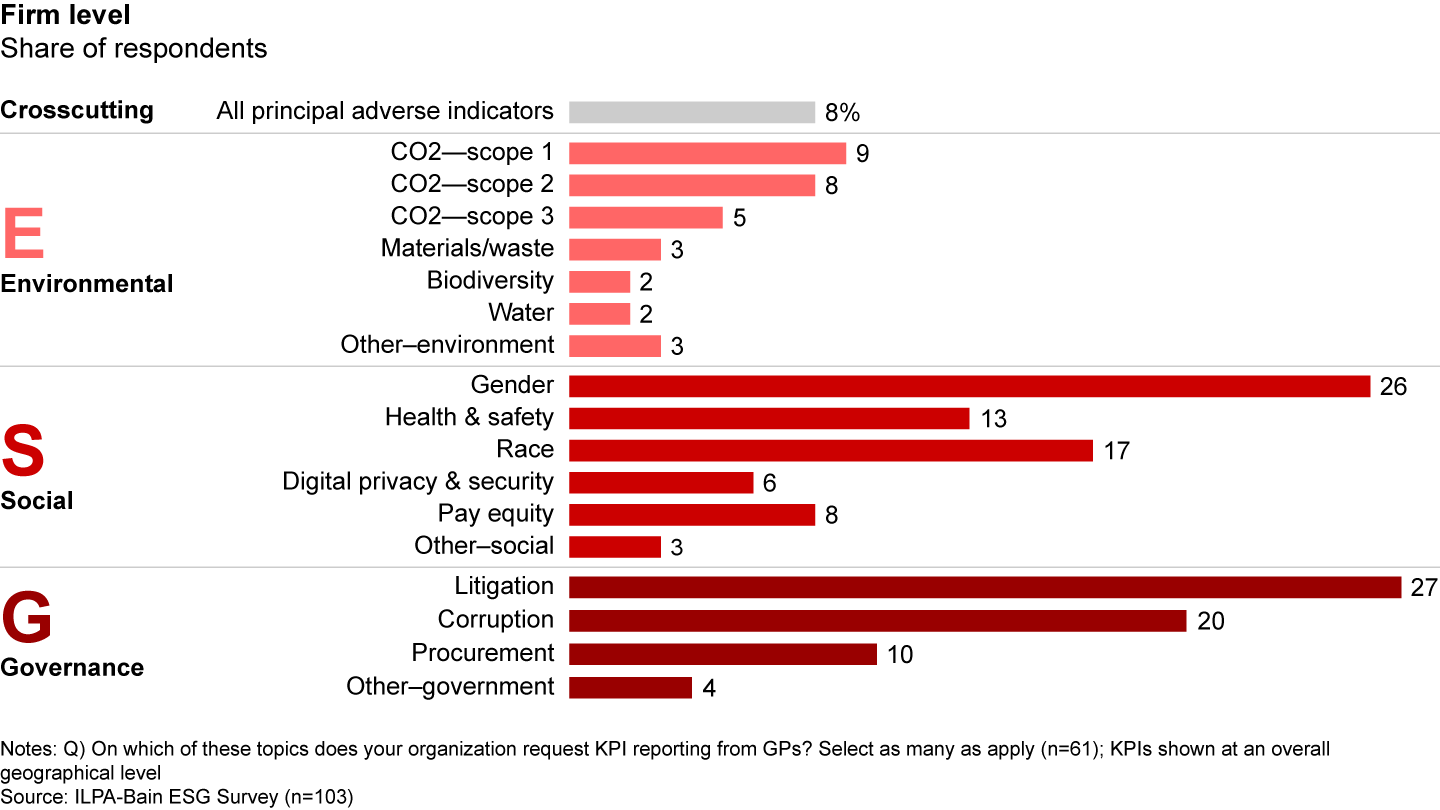Report

At a Glance
- LPs are embracing ESG integration at increasing rates as implementation, awareness, and mobilization have passed the tipping point.
- In the past, ESG efforts were primarily viewed as good PR to receive favorable press, please socially conscious employees, and mitigate risk. Today, ESG considerations are increasingly viewed through the lens of value creation, though perspectives differ by geography.
- Although challenges remain to accurately monitor and measure ESG, a thoughtful approach to ESG integration is becoming a must-have for LPs—so much so that future deals and investments could be jeopardized if such considerations are absent.
- LPs and GPs can take advantage of a growing number of tools and options as they plan concrete strategies, set priorities, balance environmental and DEI initiatives, and conduct ongoing evaluations to monitor ESG progress.
Environmental, social, and corporate governance (ESG) standards are rising in importance. This is true for businesses worldwide, especially for limited partners (LPs). LPs see progress in ESG initiatives as delivering multiple benefits.
The days of seeing ESG efforts as just a check-the-box, risk-mitigation exercise are ending. More and more, LPs view ESG factors as additive to investment performance. Furthermore, a lack of strategy for thoughtfully managing ESG considerations can cause proposed deals to face obstacles—or cancellation.
Written in collaboration with
Written in collaboration with

Challenges remain. A measurement gap exists that is difficult to reconcile, though improvements are accelerating. For example, net-zero carbon until recently was a vague concept. Now, emissions footprints can be measured more accurately. Still, collecting quality, comparable ESG data across an investment portfolio is posing real challenges. Investors must navigate numerous methodologies, frameworks, and approaches to translate ESG policies into concrete, data-driven processes and actions.
Given market dynamics, what do LPs really think? To find out, the Institutional Limited Partners Association (ILPA), in partnership with Bain & Company, surveyed more than 100 LP organizations. Their responses, along with some follow-up interviews, provide valuable insights into recent ESG developments and concerns among LPs.
ESG influence passes the tipping point
From the joint survey results, the big picture is clear: ESG is now a mainstream consideration. In terms of awareness and mobilization, an increasing percentage of LPs now factor ESG issues into investment decisions and consider how they will affect private equity (PE) investments.
More than two-thirds of respondents stated that ESG considerations play a part in organizational PE investment policies. Of those LPs, around 85% include at least some ESG initiatives, with more than half having fully implemented ESG-specific policies, and 33% having partially implemented such policies. Overall, these policies affect about 76% of surveyed PE assets under management (see Figure 1).

As one respondent noted, policies can help demonstrate the level of ESG commitment. Another respondent noted that an early focus on “awareness, education, foundational policies, and processes” can accelerate a “shift to the next frontier on accountability, impact, and systemic issues.”
The LPs we spoke with indicated that many of these ESG policies reflect growing global concerns about climate change and the value of diversity, equity, and inclusion (DEI) initiatives. One respondent noted a desire “to see evidence [that general partners (GPs)] are making climate change a board-level issue” and exhibit “systematic engagement with companies on climate risk management.”
However, progress on ESG implementation varies geographically. Of the LPs surveyed, the highest rates of ESG integration exist outside North America. Only 62% of responding LPs with headquarters in North America reported having an ESG policy, while 83% with headquarters in Europe and 92% of respondents in all other regions of the world have taken this step.
The case for ESG integration: Risk mitigation versus value creation
The top reasons LPs in our survey gave for incorporating ESG considerations into their investment policies or approach are that they view them as additive to investment performance and they want to offer clear ESG communications to stakeholders. One-third of respondents credited ESG incorporation as the result of a desire to choose investments that make a “positive contribution” (see Figure 2).
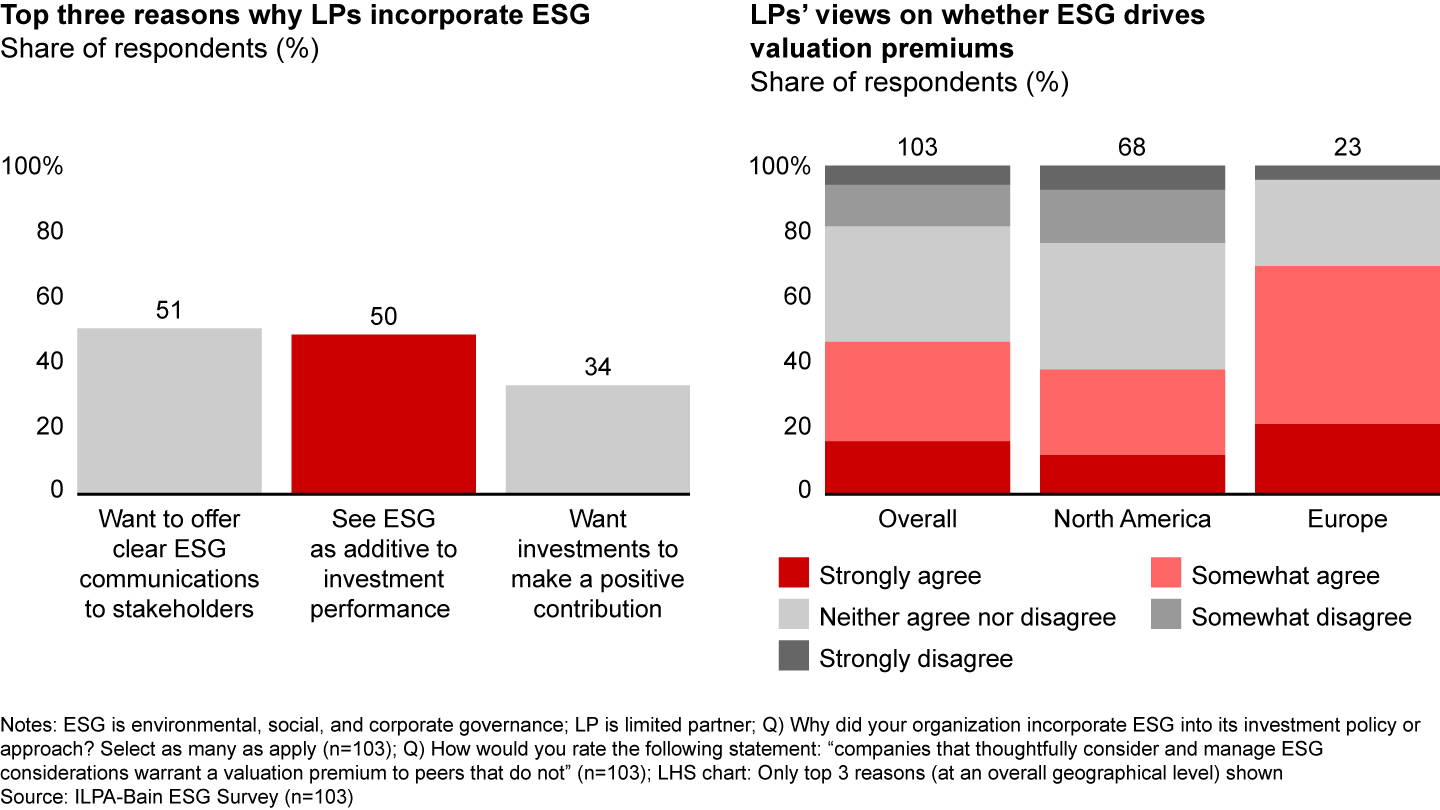
Although being “additive to investment performance” is a major reason to include ESG considerations across the investment life cycle, a wide gap exists between Europe and North America regarding the influence of ESG adoption. Of the LPs headquartered in Europe, 70% agreed or strongly agreed that ESG commitments influence valuation premiums. However, only 38% of LPs headquartered in the US held the same opinions.
The survey results spotlight the benefits of ESG incorporation—and the increasing risks of ignoring ESG considerations. Furthermore, we see an interesting pattern emerging in the primary reason for those risks.
Only 7% of surveyed LPs—all North American firms—said they would not walk away from an investment because of ESG reasons. Analysis of the reasons for walking away revealed that North American LPs are more concerned with ESG risk mitigation, whereas European LPs focus on opportunities to drive or improve ESG performance.
Nearly three-quarters of North American respondents cited the potential for negative publicity as a reason to scrap an investment; only half of European LPs shared this worry. Conversely, 44% of North American LPs considered a lack of desire to improve on poor ESG performance to be a deal-breaker, compared with 78% of European LPs. And nearly twice as many European LPs (43% and 13%, respectively) as North American LPs (26% and 6%) were concerned with a misalignment between firms’ ESG mindset and their own or with poor ESG reporting (see Figure 3).
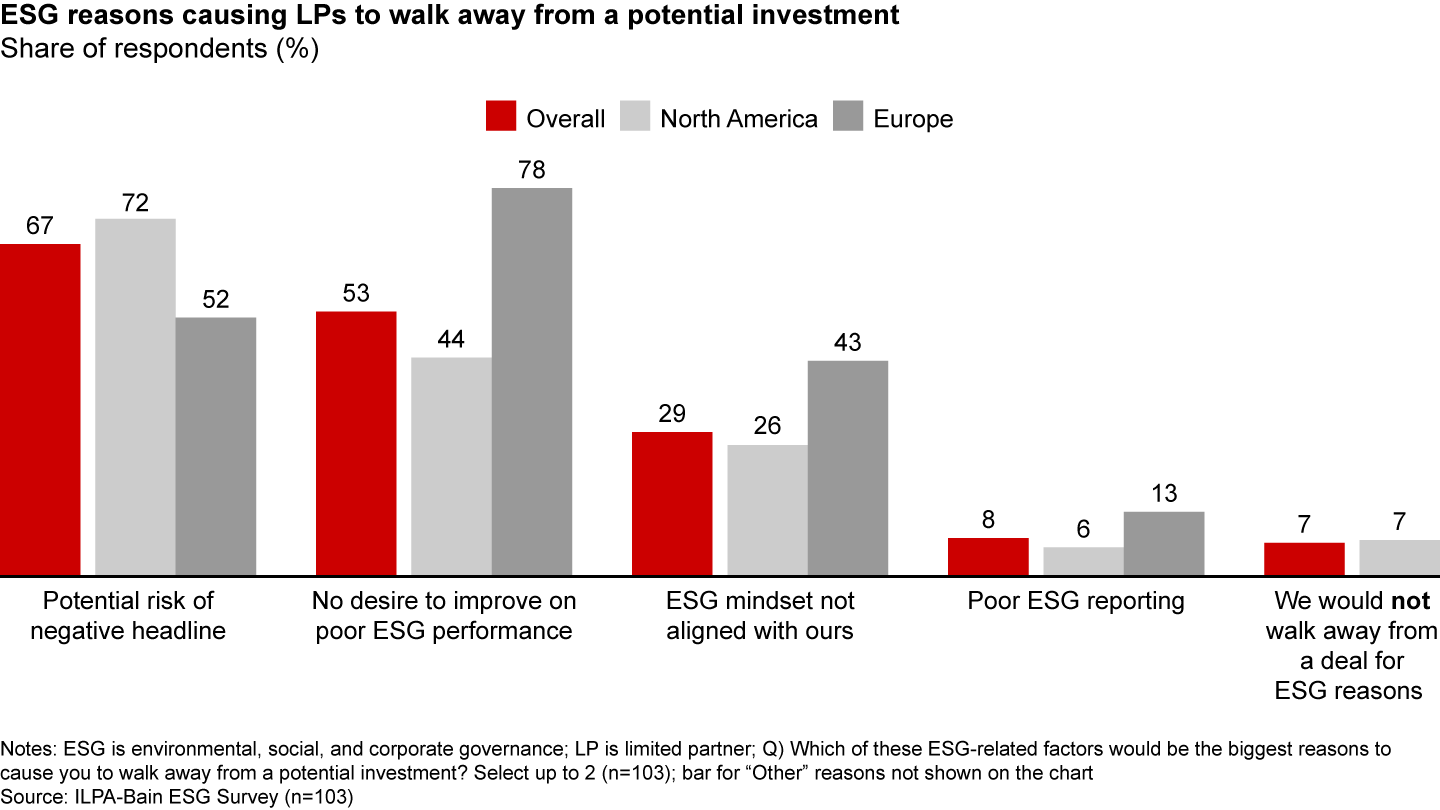
One respondent said LPs are becoming savvier about what makes ESG initiatives valuable, and they can tell “the difference between meaningful action and greenwashing.” Another recalled that the holistic incorporation of ESG standards by a firm’s leadership was the deciding factor in a tight competition between fund managers with similar performance records.
LPs respond to monitoring and measurement challenges
LPs still have the opportunity to integrate ESG considerations more effectively across the fund investment process. Firms that pursue ESG initiatives can assess potential investments on both a fund and firm level, as well as consider ESG factors during fund screening, due diligence, and portfolio management (see Figure 4).
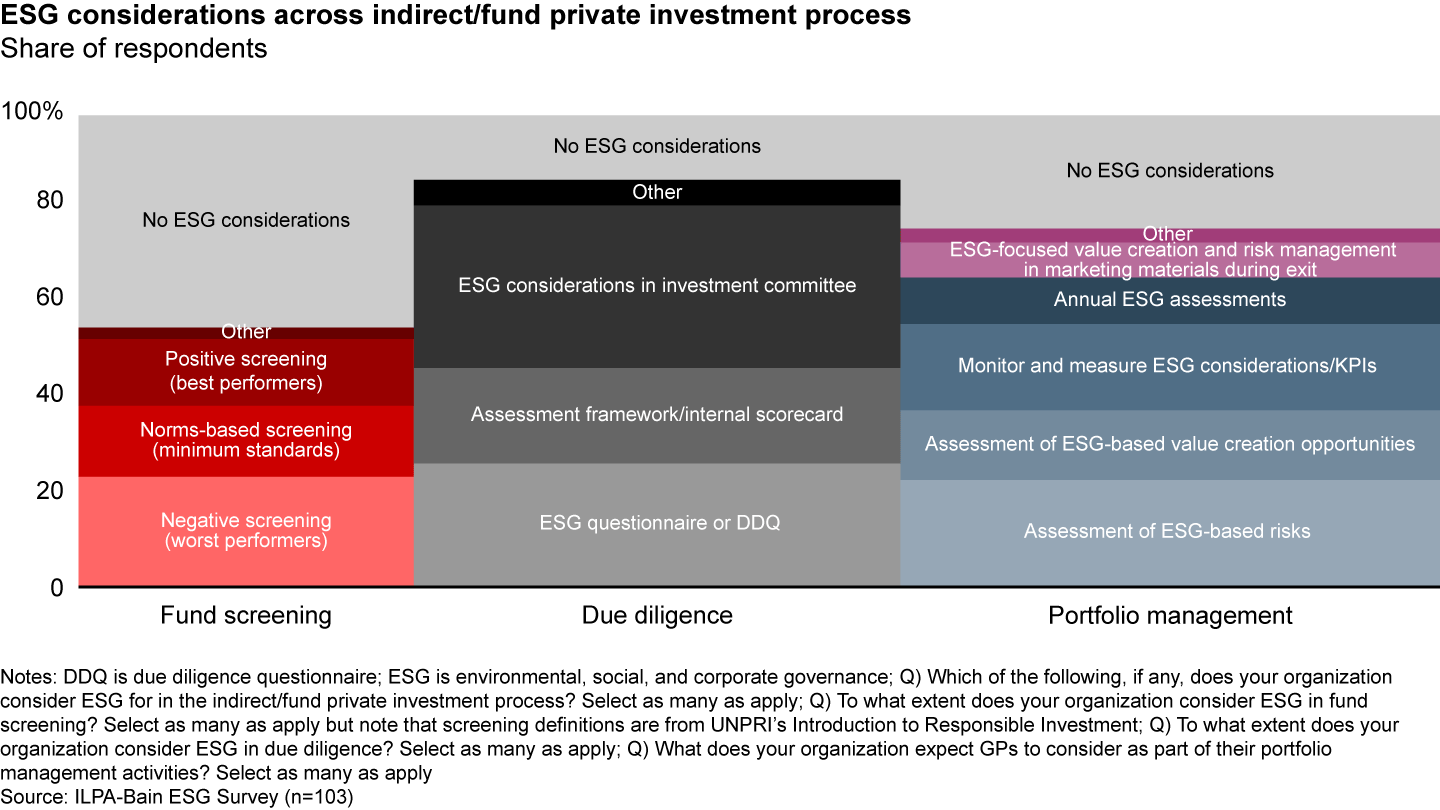
- Only 43% of respondents consider ESG initiatives during fund screening. Of those who do so, 66% use these considerations as part of negative screening (to avoid poor performers or products or services that might be controversial). About 40% use ESG information to perform norms-based screening (against minimum standards), with another 41% considering ESG initiatives part of positive screening (to identify the best performers).
- The widest adoption of ESG considerations occurs during due diligence, with nearly three-quarters (73%) considering them a factor. These LPs note ESG factors during their evaluation of investment committee discussions (84%), GP questionnaires or due diligence questionnaires (DDQs) (63%), and assessment frameworks and internal scorecards (49%).
- Only half of the respondents said that ESG adoption has implications for portfolio management, most frequently through assessment of ESG-based risk (88%), ongoing ESG performance and key performance indicator (KPI) monitoring (73%), and consideration of ESG-based value-creation opportunities (59%).
PE firms that want to demonstrate their commitment to ESG integration—and LPs that want to evaluate those efforts—face two primary challenges: difficulty quantifying and monitoring ESG performance (an issue for more than 69% of respondents) and a lack of harmonized reporting standards (noted by more than 50% of respondents).
Nearly half of surveyed LPs expressed that they want GPs to provide certain relevant or material ESG-related KPIs. Yet across most ESG themes, fewer than 20% of surveyed LPs indicated that they specifically request such reporting, and GPs face hurdles in providing relevant data to prove that their ESG efforts are more than greenwashing.
Firms need trusted data providers. However, services like data provision often have drawbacks, including a heavy reliance on estimated data and the input of very crude or inconsistent actual data. Difficulty in calculating environmental KPIs also exists: Fewer than 25% of GPs were able to provide data on scope 1 and 2 emissions all or most times that it was requested, and fewer than 30% were able to provide data on all principal adverse indicators all or most times. LPs reported higher rates of identification for social and governance KPIs, but opportunity for improvement is plentiful in those themes as well (see Figure 5 and Figure 6). Differences also exist in determining the level at which reporting should occur. For example, scope 1 and 2 emissions are more typically reported at the fund or portfolio company level, whereas gender, litigation, and corruption are more often tracked at the firm level.
Our research indicates that ESG initiatives and considerations will continue to trend upward. For some LPs, a lack of accurate data and predictable measurement solutions significantly hinders their pursuit of ESG priorities. The good news is that we anticipate rapid improvement in the availability of necessary data and measurement capabilities.
We see a continuing upward trend in the number of LPs that are leading the drive to incorporate ESG policies and practices in their investment value chain—and that ask for and seek to validate measurable progress. Their desire is reflected in our research, which indicates that 80% of responding LPs expect to ramp up requests to GPs for ESG reporting during the next three years (see Figure 7).
Figures 5-6: Figure 7
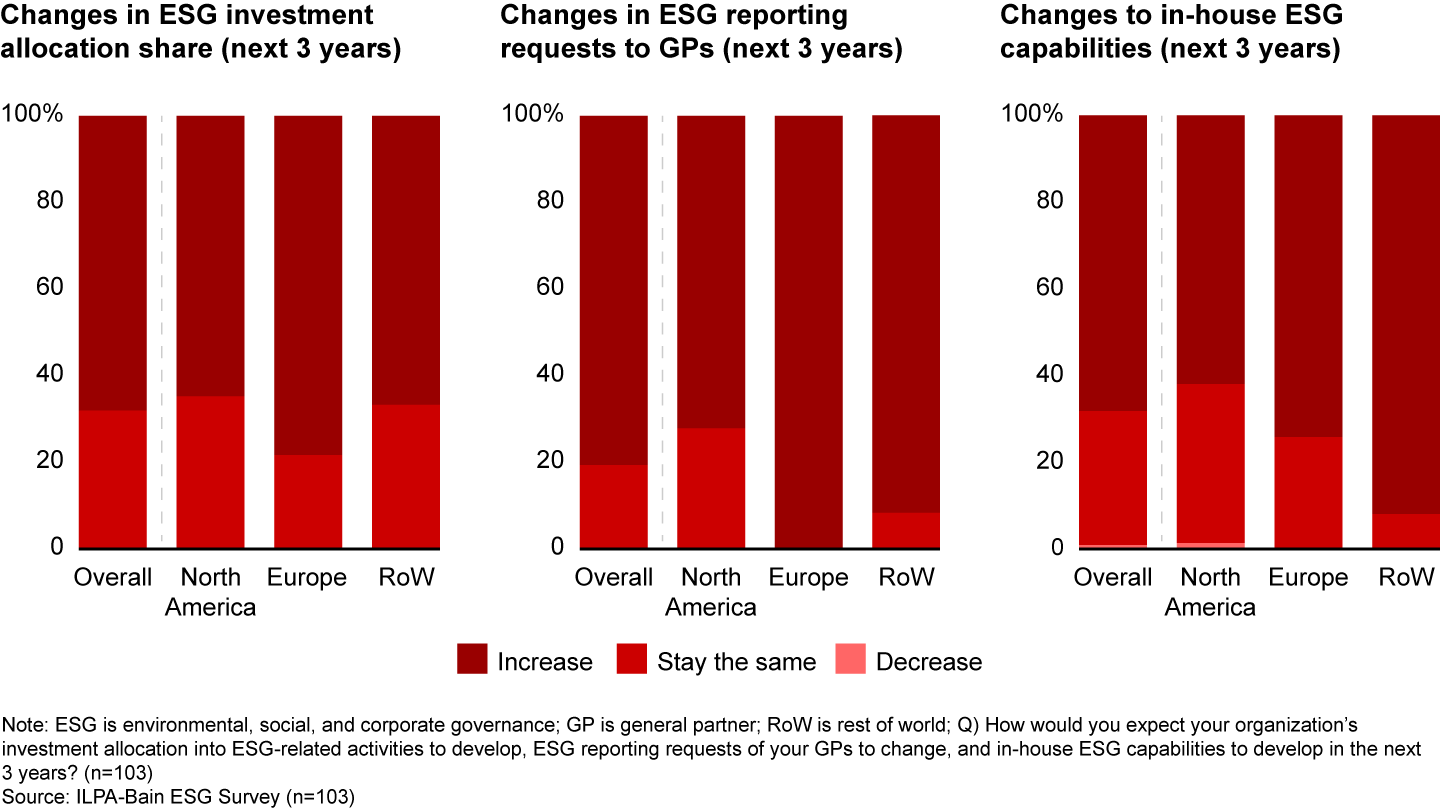
For example, one respondent has developed a taxonomy to determine whether potential investments are meeting Sustainable Development Goals (SDGs). LP recommendations are included in the underwriting of each fund and serve as a tool to assess progress between fund-raising efforts. Another launched an ESG roundtable discussion with GPs, enabling stakeholders to share knowledge, experience, and progress.
Measurement techniques are also improving, with capabilities evolving as technology advances. Firms can also hire staff to oversee data and enhance transparency in ESG reporting. And third-party experts can help firms track metrics and build reports. We expect such efforts to help LPs gain more detailed insights and encourage further progress.
Indeed, 68% of surveyed LPs expect to increase their ESG investment allocation and in-house ESG-related capabilities over the next three years. This period will be vital to both LPs and GPs to overcome measurement challenges, translate policies into concrete data-driven processes and actions, and develop reliable ways to measure impact and compliance. Firms have little to risk and much to gain by advancing ESG initiatives, including tracking and reporting.
The ILPA-Bain ESG Survey shows that ESG adoption is a differentiator for LPs and GPs in private equity. When done correctly, LPs can boost ESG outcomes while growing financial ones.
As more GPs and LPs earn ROI from ESG initiatives, these additions will become more vital for overall firm or portfolio company performance. Improved measurement techniques should boost ESG performance while also leading to other gains. Companies will be positioned to win market share, hire and motivate the best people, build the best supply chain, and avoid irresponsible behavior risks.
Next steps for LPs and GPs to capture value from ESG adoption
To move from high-level ESG policies to tangible performance-based processes and actions, LPs and GPs should focus on the following steps:
- Make ESG policies and fund strategies as concrete as possible. LPs and GPs can start by adopting well-defined, quantifiable ESG ambitions. These should be backed by operating models and purpose statements. Identify meaningful change that can be achieved for short-, mid-, and long-term targets. One LP we spoke with noted the advantage of shared, standardized questionnaires to increase efficiency in these efforts.
- Prioritize environmental and DEI measurements. Although many focus areas, including human rights, are important, the areas of environmental and DEI involve systemic, high-risk issues. More than 31% of LPs responding to our survey have set net-zero commitments, and in Europe more than half have done so (see Figure 8). One LP mentioned that they have hired a meteorologist specializing in weather-related physical risk to work with their team during the risk analysis process.
- Embed ESG evaluation into every step of the investment value chain. This includes fund and sector screening, due diligence, and portfolio management. GPs and portfolio companies should study performance based on ESG KPIs to drive engagement with ESG-linked value creation. As one respondent said, “There’s so much opportunity to do more. We’re starting to think more strategically about where we want to be five years from now.”
- Facilitate capability building across the PE industry. LPs can increase capabilities by expanding internal resources and having in-house teams coordinate on ESG initiatives. One survey respondent said their in-house PE program began 10 years ago, with ESG standards a core part since the program’s inception. Growing in-house expertise over the long term can simplify adoption of future ESG initiatives.
Figures 5-6: Figure 8

Challenges exist, but a wait-and-see approach runs the risk of missing strategic value-creation opportunities and providing an opening for rivals to widen the competitive gap. Fortunately, LPs and GPs have multiple—and growing—options for improving ESG performance.
ILPA provides a Due Diligence Questionnaire and Diversity Metrics Template intended to standardize the key areas of inquiry that investors use during their due diligence of managers and provide a framework for ongoing monitoring of progress related to DEI. ILPA also offers an ESG Assessment Framework designed to help LPs evaluate and benchmark GP responses to due diligence efforts, inform goal-setting conversations with GPs, and measure ESG integration progress over time. Both are trusted, publicly available resources for the PE community.
Bain & Company says companies can also turn to the growing number of third-party firms that help establish baseline performance and track progress over time. Bain itself has taken minority stakes and established strategic partnerships with two such firms: Persefoni, which offers a climate management and accounting platform, and EcoVadis, whose business sustainability rankings for global supply chains provide investors insights into ESG maturity.
Whichever solutions companies choose, the focus on ESG adoption is here to stay. The growth exhibited in our survey points to a future of increasing ESG initiatives. LP and GP leadership who act now will be well positioned to meet the resulting demand.
This report was prepared by the leadership team of Bain & Company’s Global ESG Private Equity team in conjunction with ILPA with special direction from Axel Seemann, advisory partner, and an editorial team led by Maggie Locher. The authors wish to thank in particular Jackie Han, ESG Private Equity manager, and Theresa Reisch, consultant, for their significant contributions to this report.

About the Institutional Limited Partner Association
With more than 575 member institutions representing over 2 trillion USD of private equity assets under management, the Institutional Limited Partners Association (ILPA) is the only global organization dedicated exclusively to advancing the interests of LPs and their beneficiaries. Our members include public and private pensions, insurers, endowments and foundations, family offices, development finance institutions, and sovereign wealth funds. Our policy agenda is focused on strengthening the private equity asset class through strong governance, alignment of interests, and transparency.

